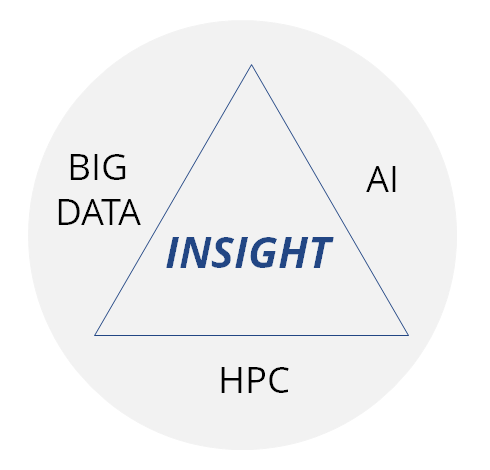At ASF 2019: The Virtuous Circle of Big Data, AI and HPC

We've entered a new phase in IT -- in the world, really -- where the combination of big data, artificial intelligence, and high performance computing is pushing the bounds of what's possible in business and science, in work and play. What new creations this virtuous circle will yield has yet to be seen, but if what we've seen up to this point is any indication, it's bound to impress.
When viewed as independent fields, you can see real gains made in big data management, AI, and HPC. It's fair to say that each discipline is on its own upward trajectory. Each has its own challenges and its own roadmap for overcoming those challenges to bring success to their practitioners.
 But when you view those three fields as a cohesive whole, one gets the sense that something much bigger is under foot. If technology is subject to evolutionary forces and moves forward in an evolutionary manner, it seems like we're about to enter a period of punctuated equilibrium, driven by the collective power of those three engineers.
But when you view those three fields as a cohesive whole, one gets the sense that something much bigger is under foot. If technology is subject to evolutionary forces and moves forward in an evolutionary manner, it seems like we're about to enter a period of punctuated equilibrium, driven by the collective power of those three engineers.
Together Tabor Communications Inc. CEO Tom Tabor, the three managing editors of TCI publications, including Alex Woodie of Datanami, Doug Black of EnterpriseAI, and Tiffany Trader of HPCwire, explored the virtuous cycle of big data, AI, and HPC this week during a panel discussion at Advanced Scale Forum, TCI's annual event.
Here is an edited version of the editor's discussion with Tabor:
- Big Data: The Feedstock of AI
 Since the dawn of time, data management has posed a challenge to mankind. From oral histories and cave paintings to handwritten scrolls and Guttenberg's printing press, we've always maxed out our data storage capabilities and run into I/O bottlenecks.
Since the dawn of time, data management has posed a challenge to mankind. From oral histories and cave paintings to handwritten scrolls and Guttenberg's printing press, we've always maxed out our data storage capabilities and run into I/O bottlenecks.
The creation of the World Wide Web 30 years supercharged the data management opportunity, as well as the challenge. By interconnecting the lives of 4 billion people through PCs, smart phones, and social media, we've witnessed a classic "network effect" unfold, fueling an exponential growth of data that's expected to top 40 zettabytes by 2022.
Every minute of every day, Snapshat users share half a million photos, half a million Tweets are sent, half a million Facebook comments are lodged, and 4.1 million YouTube users are watching a video. Every minute, there are 16M text messages, 156 million emails -- about two-thirds of which are spam (the rest, presumably, involve cat videos).
The problem, of course, is managing all this data, about 70% to 80% of which is unstructured, is hard. Before we can do fancy analytics, machine learning, or AI upon it, the data must be brought under control, protected, governed, cleansed, cataloged, and tracked.
This is the big data problem, and it's why only a handful of companies have managed to find terminal velocity with their big data efforts. The difficult of managing big data is what Ali Ghodsi, the CEO of Databricks and one of the early developers of Apache Spark, called "AI's 1% problem."
There are a number of ways people are working to solve the data management problem. Things like data fabrics, data catalogs, federated databases, and tools for building repeatable data pipelines, will all be part of the solution. But the fact remains that there's no silver bullet for data management. One must get in there, get dirty, and find what works to solve one's own data challenges.
But once you wrangle the data, the potential benefits of AI are enormous.
- AI's Enormous Potential
In many ways, the hype over big data has shifted to artificial intelligence, which has become the driving force behind many organization's data collection and data monetization efforts.
IBM's CEO Ginni Rometty recently commented that the enterprise opportunity around AI is revolving around several dimensions as AI evolves from its first chapter, characterized by departmental level, PoC “random acts of digital” to chapter two: enterprise-wide AI. It will involve scaling AI, embedding it everywhere in the business, in a hybrid fashion that spans on-prem and cloud infrastructures, including infusing it into mission-critical applications.
A big challenge around AI, however, involves how to take AI from the prototype phase into production. IBM's advice boils down to "think big, start small, and move fast.” As one department finds success with AI, confidence will build, and pretty soon, more departments will gravitate to the technology, and even the C suite will get behind it.
Another piece of advice for scaling AI comes from Ed Abbo, who is president and CIO at C3, which has implemented some of the largest AI applications outside of Silicon Valley. There are three main ingredients, Abbo said, including
- Automated data management, meaning ingestion, aggregation and cleansing of data from the hundreds, even thousands, of systems across the enterprise to derive a holistic view of company operations and customer behavior;
- Rapid testing and deployment of pre-built AI models, which significantly accelerate the work of data scientists;
- Scalability, via public and private clouds and distributed computing techniques, which enables the company to spin up and shut down cloud resources as machine learning inferencing is needed on fluctuating volumes of incoming sensor data.
"Unless you’ve got all three elements," Abbo says, "you’re still in the prototype world.”
- HPC's Necessary Boost
Despite the progress we've made through the "big data boom" and the current "hype rocket" that's taking off around AI, the dirty little secret in the industry is that less than 2% of the world's data is being utilized for analysis. If we're going to push the needle past 2%, it's going to take a lot of horsepower. Whether it’s scale-up capability supercomputing for the DOE or some variant of scale out – in the datacenter, in the cloud, at the edge, in our phones, our space shuttles, boats and cars -- organizations will require massive amounts of compute.
Satisfying this need has resulted in a growing ecosystem of speedy interconnects, new storage technologies, and specialized processors (think GPUs, TPUs, FPGAs, and whatever else is coming down the pike).
Machine learning’s potential has been unlocked by the rise of big data and the availability of compute. This is the virtuous circle -- the connection between big data, AI, and HPC -- and it's really at its infancy. The "virtuousness" of the cycle has been explained well by Andrew Ng of Landing AI, where better data creates new and better products, which in turn attracts more users, which yields even more insights. It's a cycle that is undergirded by fast compute for training models and for deploying them in the field for inferencing.
With so much hype circling about AI, big data, and emerging "edge to core" computing paradigms, it's important to remind ourselves not to get too far over our skis. Nobody wants to repeat the “AI winter” mistakes of the past, or break out jars of Hadoop to smear about like some cure-all, as Intersect360 Research's Addison Snell pointed out during his ASF panel.
With that in mind, it's also worth reminding ourselves of Amara’s Law, which speaks about the difficulty of forecasting the effects of technology. The law states that we tend to overestimate the effect of a technology in the short run and underestimate the effect in the long run.
The virtuous cycle of big data, AI, and HPC, use of which is mostly confined to the upper reaches of enterprise and the FAANG companies, has already yielded amazing gems (NLP, image and facial recognition, etc.) that have impacted the business world and the public domain. And when taking the long view, the odds look quite favorable that this cycle -- which really is the essence and the epitome of human achievement as it pertains to information, software, data, and hardware -- will evolve and proliferate to drive the state of the art and expand the realm of the possible for decades to come.










